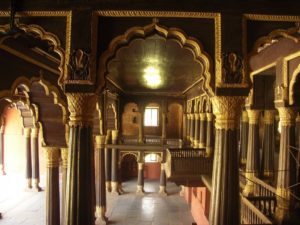There is a slice of history embedded in the IT capital and electronic city of South India, Bengaluru, which will go down in history as the glorious era of Karnataka history: the Mysore Rule led by Hyder Ali and his son Tipu Sultan. The Tipu Sultan Palace in Bengaluru is housed near the bustling City Market at the junction of Krishna Rajendra and Albert Victor Road. The palace lies in the precincts of the fort.
 The Tipu Sultan palace in Bengaluru was the summer retreat of the great Mysuru Ruler, who fondly termed it the “Rash-e-Jannat”, or “Envy of Haven” or “Abode of Happiness”. One can get to see this engraved on a window screen. Splendid gardens all along the path, leading to the palace, along with sparkling fountains and lovely flower beds, will welcome you.
The Tipu Sultan palace in Bengaluru was the summer retreat of the great Mysuru Ruler, who fondly termed it the “Rash-e-Jannat”, or “Envy of Haven” or “Abode of Happiness”. One can get to see this engraved on a window screen. Splendid gardens all along the path, leading to the palace, along with sparkling fountains and lovely flower beds, will welcome you.
The place speaks volume about Tipu’s valiant attempt to protect Karnataka from British imperialism. That is why the Tipu Sultan palace should be tagged along the places to visit in Bengaluru. The place was opened to public view in 2005.
In 1537, Kempe Gowda, founder of Bengaluru, raised the fort. The extension was later carried out by Tipu Sultan. It is said that Hyder Ali put several British army officers including David Braid behind bars. The construction of the palace, which was started by Hyder Ali in 1781, was completed by Tipu in 1791. The place later came to be known as “Tipu’s Palace”.
The entire palace, styled on the Indo-Islamic art and architecture, is constructed of teak wood, stone, mortar and plaster. It is raised on a stone plinth. A striking feature is the intricately carved pillars that support the mammoth wooden beams throughout the palace. A congregation of wooden pillars, which rests on the stone base, support the entire structure. The pillars are converged with brackets and cusped arches adorned with stunning carving accentuated in multi-colours. Every pillar’s base has the carvings designed as if they come out of flowers. The ceilings and the walls boasts of madder-red surfaces decorated with floral motifs for an elegant look. Four staircases from the ground floor lead you to the first floor. There is a large hall on the first floor having four rooms, one at each corner. Known as the Zenana quarters, only the ladies of royal households had access to it. You can see two projecting balconies, one located on the east, another on the west side. It is believed that Durbars were held by the Sultan in the hall to run the administration matters of the state with the state officials in the balcony area, watching the proceedings.
The British later used the palace as their secretariat following the death of Tipu Sultan. The palace-turned museum showcases some of the artefacts of the ruler including the portraits of places and places of the bygone era, done by modern-day artists, and represents the grand lifestyle of the royals. The Sultan’s crown and his clothes are exhibited in silver and gold pedestals. Among other prized possessions, silver vessels offered to Hyder Ali by a general are also on display.
There is a splendid and a well-preserved temple of Lord Ganesha, dating back to the1790s, close to the Tipu Sultan Palace in the fort enclosure, which stands as an embodiment of Tipu’s secular values and inclusiveness. The fort area also houses an art gallery that displays several paintings, pictures, fine carvings and photos of the Mysuru Sultanate era. The Tipu Sultan Palace, currently managed by the Archaeological Survey of India, not only draws tourists the year round but also remains a haven for archaeologists and historians. Carrying eatables or camera inside the palace is prohibited.

